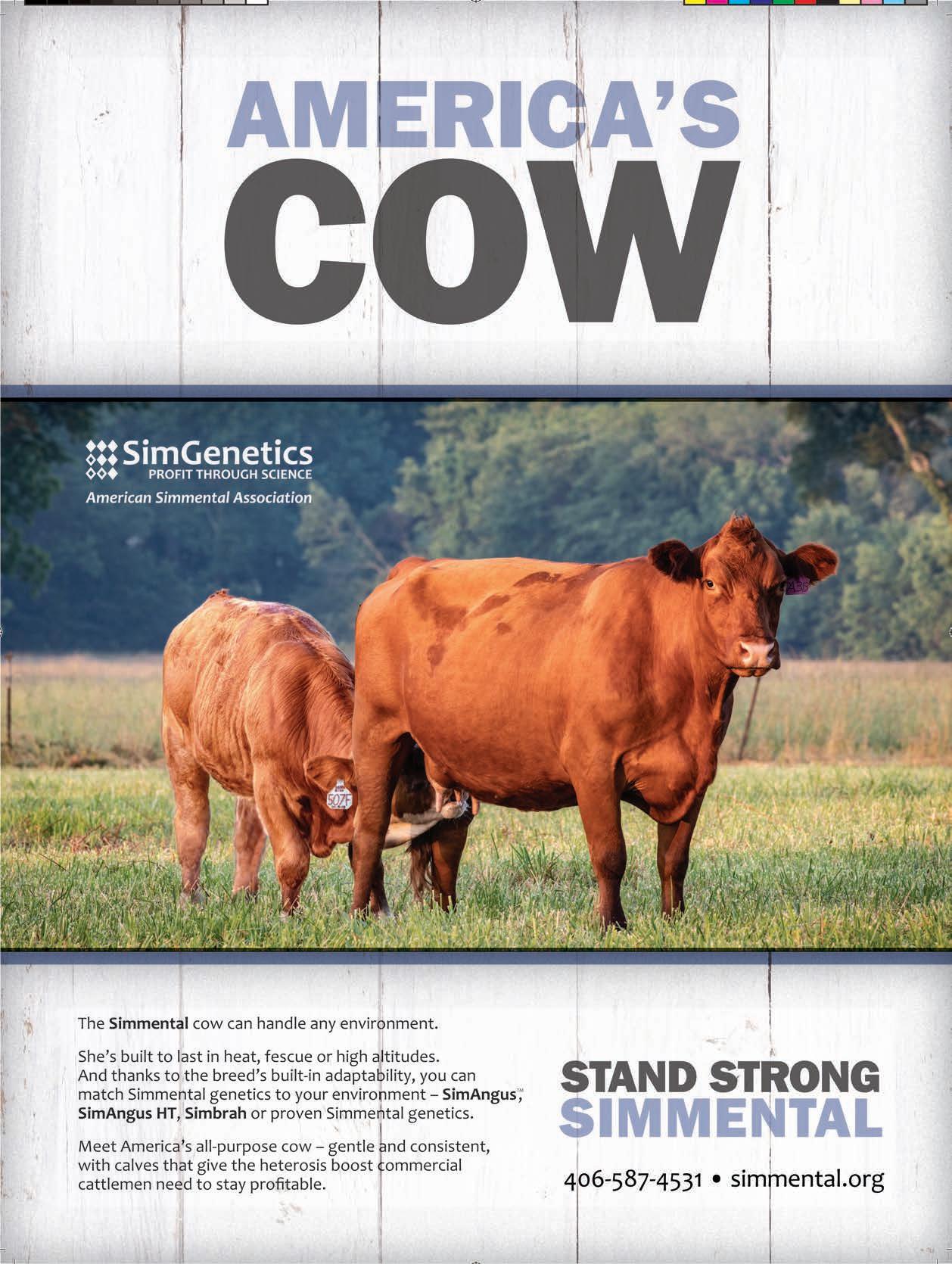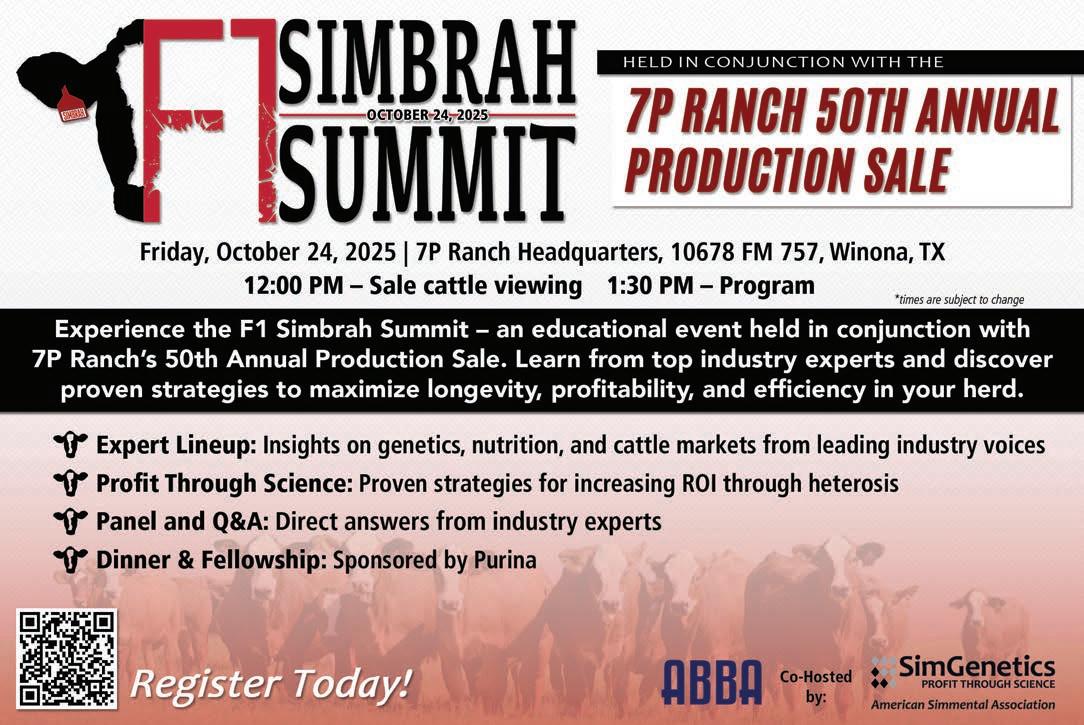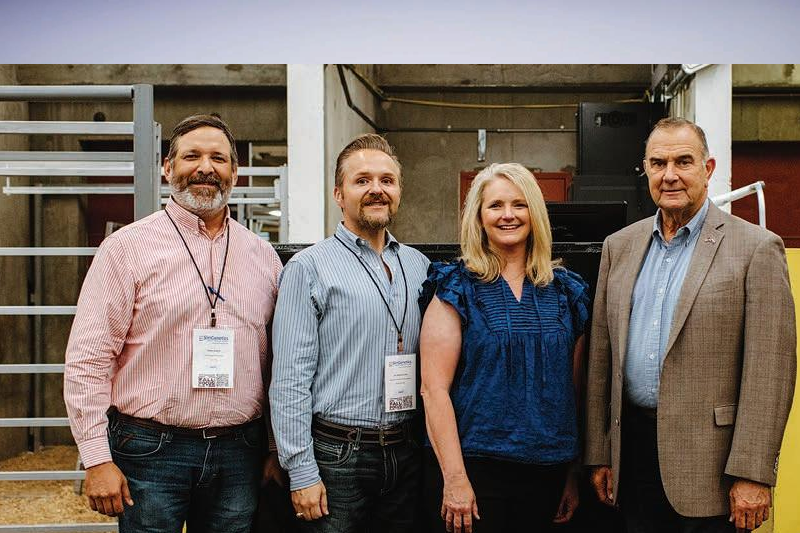by Lilly Platts, photos by ASA intern Chloe Tolar
Missouri is third in the nation for cow-calf production, and a leader in the Simmental breed.
The Missouri Simmental Association hosted a full day of education on the state’s rich beef cattle industry, kicking off Fall Focus 2025.
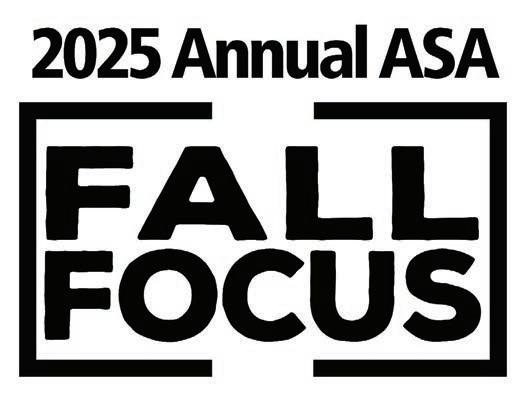
The Missouri Simmental Association helped kick off Fall Focus 2025 with a full day showcasing the state’s rich beef cattle industry. Early in the morning of Friday, August 22, producers from Missouri and beyond boarded buses for the Trowbridge Livestock Center on the University of Missouri (MU) campus.
Dr. Bryon Wiegand, professor of Animal Science at the University of Missouri, opened the morning session by covering MU’s animal science program. The undergraduate enrollment in animal science at MU is expected to be over 500 students in the 2025–2026 academic year, and continues to grow. Many of these students are on the preveterinary medicine track. The animal science department is currently constructing a state-of-the-art meat processing and teaching facility, which will further expand their ability to educate future professionals in agriculture.
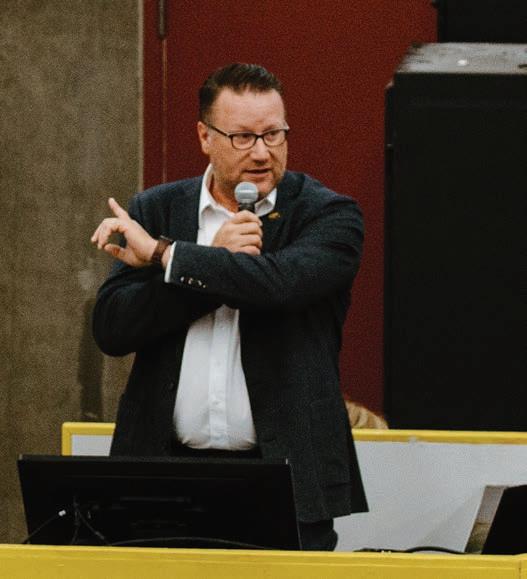
Cyndi Young-Puyear, with Brownsfield Ag News, provided an overview of Missouri’s agricultural production. Missouri ranks third in the nation for cow-calf production, just behind Texas and Oklahoma, with 1.864 million head of beef cows, up 34,000 compared to last year. The state is also home to 60,000 dairy females, and 90,000 head of cattle on feed. “This strong cow presence underscores Missouri’s vital role in the beef cattle industry,” Young-Puyear shared.
The majority of these cow-calf operations are small, family-run farms with a modest average herd size of 36 cows. The state is losing farm ground and family operations to consolidation, mirroring the nationwide trend. Despite this, Missouri’s beef industry is still driven by small family farms. “The base of the industry continues to rely on thousands of family-owned ranches, 88 percent of which are still operated by families,” YoungPuyear shared.
Demographically, Missouri also mirrors the nation, with the average age of producers at almost 58. Fewer than ten percent of producers in the state are under the age of 35. While this presents a challenge, Young-Puyear shared that there are some bright spots, including the 46,000 farmers with less than ten years of experience. Women make up one-third of the state’s agricultural producers, and there are 16,000 veterans helping grow food.
The Simmental breed has an especially strong presence in the Show-Me State. Missouri’s climate is varied, but thanks to an average annual rainfall of 35–50 inches, producers across the state can expect around 200 grazing days per year. Many of the families raising SimGenetics cattle in Missouri have been involved for generations. Young-Puyear shared, “Over the decades, Simmental genetics have become deeply woven into the fabric of Missouri’s beef cattle industry.”
Fescue is present in many Missouri pastures, presenting challenges for cow-calf producers. The fungal endophyte in toxic tall fescue produces ergot alkaloids, which restrict blood flow. This restricted blood flow leads to poor nutrient delivery to hair follicles, which can cause delayed hair shedding. Missouri summers can be hot and humid, so this delayed shedding, or rough hair coat, can lead to serious heat stress, weight loss, and a lowered productivity. Simmental cattle are known for adaptability to fescue, but still, genetic progress is needed to improve this issue, which costs the beef industry one billion dollars annually.
Dr. Jamie Courter, assistant professor and State Beef Extension Specialist at MU, provided an update on innovations in fescue tolerance research and genetics. Hair shedding is an economically relevant trait that is moderately heritable. Hair shedding scores, when reported to universities and associations, help tie this trait to specific genetics that are either tolerant or resistant to fescue. Courter shared that collecting these scores should be
handled in the same manner as any trait. She also emphasized that hair shedding and hair coast are two entirely different measures. Cattle can have somewhat curly hair, straight hair, thick hair, etc., much like people; what matters isn’t the texture of the hair, but how efficiently it sheds each spring.
Age impacts hair shedding, which means that older cows should not be viewed the same as heifers. Selection decisions should be made based on these age groups, either focusing on young animals, or older females. “Younger cows will always on average have higher hair shed scores than their older counterparts,” Courter said.
Management is extremely important in hair shedding — nutrition, stress, and parasites can draw energy away from hair shedding. For producers, especially in areas like Missouri, to fully understand their herd’s hair shedding status, management needs to be in order. MU maintains a database of 11,000 hair shedding scores, available for public viewing.
Next, Dr. Teagan Schnurbusch, assistant Extension professor and State Extension Specialist in Meat Science at MU, shared about her beef-on-dairy research. In 2018, the industry saw a major uptick in the number of dairycross cattle entering the feed yard, and in 2024, there were more beef-on-dairy calves in the feedlot than straight dairy, signifying an overall shift in the industry. Dr. Schnurbusch and her team studied the carcass differences among dairy, beef-on-dairy, and beef cattle.

The study included SimAngus-sired calves and straight dairy calves that were fed under a uniform protocol, using a Growsafe system to measure feed intake. The cattle were harvested at MU’s meat lab, and wet-aged. Using an advanced imaging system, the team analyzed various attributes of each steak, including size, shape, and quality. Steaks were also placed in a simulated meat case to observe differences in color, which often impacts consumer choice on grocery stores shelves. The SimAngus, dairy-cross cattle had a shorter, more compact carcass, and ribeye size was notably bigger than the straight dairy cattle. At the time, these SimAngus, dairy-cross cattle would have earned $300 more per head than their straight dairy counterparts, which would be even more in today’s market. In a second study, the team added 100 percent SimAngus steers and heifers to the study. In the end, the straight beef cattle were notably more fat, demonstrating the differences in how dairy cattle carry fat.
MU is continuing beef-on-dairy research. Graduate student Annika Donlick presented a preview of her upcoming study, which will analyze phenotypic differences of beef and dairy animals. A survey of dairy producers showed that while many animals they are selecting for will enter the feedlot, carcass traits are usually not considered. Calving ease and milk, which are of course important for dairy producers, continue to be the priority, even for animals they know will be terminal. Donlick’s research will further explore this, with the goal of better understanding the impact of sire genetic merit on beef-on-dairy calves.
The morning session closed with three guests who are extremely influential in Missouri agriculture. Chris Chinn, Missouri director of Agriculture, spoke about the overall
impact of agriculture in the state. Agriculture is a 93.7 billion dollar industry in Missouri, and ranks in the top ten for many commodities. The state’s Boothill region grows a variety of crops, including rice, cotton, peanuts, and melons. The rolling grass hills of the state are home to a variety of livestock operations. Chinn discussed the future of the American Food Group beef plant, which at full capacity, will be able to process 2,400 head of cattle today. Historically, Missouri has not had a strong cattle feeding presence due to the distance required to get fat cattle to a processor, and this new facility aims to change that.
Next, MU president Dr. Mun Choi welcomed the crowd to Missouri. Choi shared about the University’s students, programs, and the importance of the School of Agriculture. He also discussed other areas where MU stands out, including in cancer research. “It is my great honor to be here and welcome you,” Choi said.
The final guest for the morning was Mike Kehoe, Missouri’s governor. Elected in 2024, Kehoe is just getting started in his work for the state, but has emphasized the importance of agriculture from the beginning. A cattle producer himself, Kehoe shared about how the cattle industry has had a positive impact on his own life. “My journey in agriculture has been incredible. Through all my business opportunities… none of that taught me how to make decisions like agriculture did,” Kehoe said. “I am very passionate about the agriculture industry.”
Please watch for the November Register, which will include further coverage of Fall Focus 2025. .
